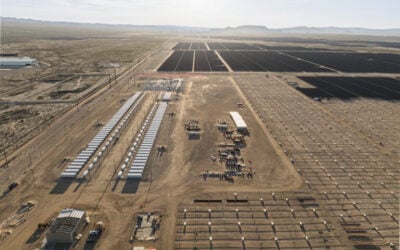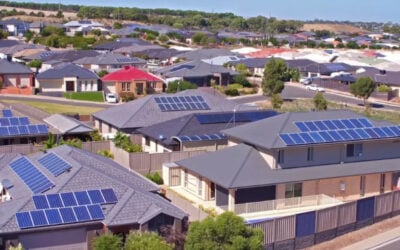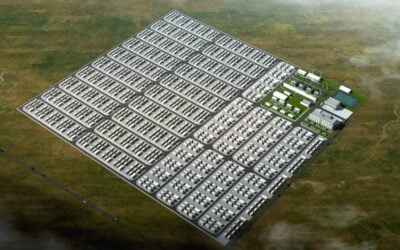
Virtual power plants (VPPs) are networks of small-scale, distributed energy resources (DERs), such as solar panels or batteries (and in some instances batteries in vehicles), which can together function as a single power plant, providing stability to the electric grid.
VPPs can disrupt the centralised model of electricity networks built around large-scale power plants. As such, many companies have been involved in creating VPP programmes, which often see solar or battery installations at free or discounted rates in exchange for use of the systems in maintaining grid frequency and reliability.
Enjoy 12 months of exclusive analysis
- Regular insight and analysis of the industry’s biggest developments
- In-depth interviews with the industry’s leading figures
- Annual digital subscription to the PV Tech Power journal
- Discounts on Solar Media’s portfolio of events, in-person and virtual
In a 2023 interview with Energy-Storage.news, Jennifer Downing, senior advisor to the Loan Programs Office at the US Department of Energy (DOE) and author of a report into virtual power plant technology, explained some of the barriers to VPP adoption.
Rather than creating one 1-hour to 4-hour duration single-site battery storage project, building a VPP takes many individually-sited home battery storage systems to achieve the same duration or capacity. Downing also explains:
“Then the second thing is how utilities are getting paid, because if you can imagine that a utility operating in an environment where a margin is only allowed for capital investment and deploying a virtual power plant requires software systems, new managers and engineers to design and operate the programme and the hard assets of the DERs aren’t counted towards your rate base, because they’re owned by the customer. There’s no profit motive for an investor-owned utility (IOU) to choose a virtual power plant over traditional resources [in that case].”
This can lead to utilities denying the interconnection of new facilities because there is not enough benefit given to the utilities for the associated costs.
With such a diversity of programmes, incentives and VPP resource types, it can be helpful to take a closer look at what several notable companies are offering either as part of VPP programme enrollment or to help manage VPPs.
We look at five companies dealing with VPP technology and software to gain insight into how they operate.
SOLRITE teams up with sonnen to launch VPP purchase agreement in Texas
SOLRITE Energy and sonnen have announced the launch of a virtual power plant power purchase agreement (VPA) in the Electric Reliability Council of Texas (ERCOT) market.
The programme will see SOLRITE install solar panels and sonnen batteries at eligible customer households without an upfront cost. Homeowners will pay a ‘lower-than-average’ rate for solar energy from a SOLRITE-partnered utility based on what their home system generates each month.
The sonnen batteries provide backup power for the homes while enabling homeowners to join the VPP. Texans participating in the SOLRITE programme pay a leading rate of just 12¢ per kWh for solar energy, significantly lower than the 19¢ – 20¢ per kWh rate commonly seen in the state.
Sonnen says this programme differs from traditional solar buyback programmes in that the sonnen battery network strategically controls when and how energy is shared with the grid rather than sending extra energy to the grid during sunny weather.
TransnetBW qualifies sonnen home energy storage units
Sonnen is a German and US residential battery storage and VPP provider. The company deploys home batteries and aggregates them into VPP networks which can then provide support to the grid. It launched its first products in 2010 and was acquired by oil and gas major Shell in 2019.
Transmission system operator (TSO) TransnetBW has qualified sonnen’s home energy storage units in Germany, which are networked to form a VPP.
The approval from TransnetBW allows sonnen to add further parts of its VPP in the TSO’s control area to provide primary control power.
With primary control power, the transmission system operators continuously stabilise grid frequency. If production and consumption deviate from one another, for example due to the unplanned failure of a power plant, the frequency changes and the grid operators counteract this with control power.
Customers can connect their solar and home energy storage systems to the sonnenVPP and receive a share of profits from the company.
The company also operates VPP networks in Australia and Italy, using lithium iron phosphate (LFP) battery cells for its batteries.
Sonnen partnered with ES Solar in the US to sell over 18MWh of energy storage systems in Utah, as part of the ‘Go Back’ programme. The programme, enabled by Rocky Mountain Power (RMP), allows Utah homeowners with current solar PV installations to add a grid-interactive smart sonnen battery.
In summer of 2023, it was announced that Shell was putting sonnen up for sale. This move came after Shell sold its entire retail electricity customer business in Germany and the UK to British rival Octopus Energy. Currently, sonnen is still owned by Shell.
VPP software solution, Leap launches in PJM
US-headquartered Leap offers a software-only solution for launching and scaling VPPs. The Leap software facilitates access to demand response and other grid services revenue stream for providers of BESS, electric vehicle (EV) chargers, smart building technologies and other distributed energy resources.
The company announced 5 February, its entry into the PJM Interconnection wholesale market. Regional transmission organisation (RTO) PJM coordinates the movement of electricity through all or parts of Delaware, Illinois, Indiana, Kentucky, Maryland, Michigan, New Jersey, North Carolina, Ohio, Pennsylvania, Tennessee, Virginia, West Virginia and the District of Columbia.
Leap’s software will allow customer devices within the PJM service area to automatically adjust energy usage to help balance the grid during emergency events. The company says that Leap Connect, its customer enrolment tool, can be used to streamline registration and data authorisation processes.
Leap’s technology partners can manage Leap-connected VPPs across different electricity markets and deploy offerings in new regions.
In 2023, Leap raised US$12 million in equity investment from industry tech investment group Standard Investment, which led the funding round, DNV’s VC arm DNV Ventures, and sustainable built environment investment group Sustainable Future Ventures. Also taking part were existing investors in the company including National Grid Partners and other VCs.
Sunrun’s 2024 VPP expansion
Residential solar and battery installer Sunrun saw more than 20,000 customers participate in 16 VPP programmes across nine states and territories in 2024.
At the end of August 2022, Sunrun sent media including Energy-Storage.news a press release claiming that it was dispatching more than 80MW of stored battery capacity from customers’ homes into California’s grid every day.
In 2023, Sunrun CEO Mary Powell said in an earnings call that Sunrun is “rapidly transitioning to a storage-first company,” which would be a significant departure from the company’s background in residential solar power generation. The company saw a dramatic increase in storage capacity installations from 2022 to 2023.
In early 2024, the company published its 2023 full-year results, showing that it deployed 1.01GW of new solar in the year. The percentage of solar projects built with co-located storage facilities – at Sunrun increased considerably over the course of 2023, from 14.9% in the first quarter of the year to 45.2% in the fourth quarter of the year.
Sunrun recently shared examples of its 2024 performance.
In Maryland, the company launched what it says is the nation’s first bidirectional electric vehicle-to-home VPP. The company partnered with Baltimore Gas and Electric Company (BGE) to utilise customer-owned Ford F-150 Lightnings. The US Department of Energy (DOE) awarded grant funding to BGE to create the programme, while Sunrun developed and operated the electric vehicle VPP.
Chris Raucher, Sunrun’s director of market development and policy said of utilising the Ford F-150 Lightnings while speaking with Energy-Storage.news:
“The scale of the resource here, it’s 130kWh for a long-range truck. You have power for many, many days if the grid goes out and then if you have solar, you have power indefinitely because you can recharge the batteries. Then looking at normal operation for peak events, it was 2,000MW of demand response and DERs that saved the California grid a couple of weeks ago during the crisis.”
Raucher added, “We’ve done the modelling that shows that’s only 200,000 F-150 Lightnings that could have provided that. It sounds like a lot, but Ford sold 125,000 internal combustion F-150s last year in Texas alone. They sold around 850,000 nationwide, so it’s really not that many trucks that would have been able to keep the California grid up, and those trucks could have done that for 13 hours.”
New York saw customers receiving a free or heavily discounted home battery in exchange for committing to Sunrun’s residential VPP programme, in collaboration with Consolidated Edison subsidiary Orange & Rockland Utilities.
In Texas, Sunrun partnered with Tesla Electric and Vistra on two VPPs. The Tesla Electric programme uses home batteries to provide reserves during peak energy consumption. In this programme, customers receive an annual payment of US$400 per Tesla Powerwall and Sunrun earns recurring revenue. Meanwhile, Vistra offers incentives and credits.
Sunrun saw over 16,000 participants in California’s CalReady programme, which delivered an average of 48MW of stored solar energy to the grid during peak evening hours in the summer, with output peaking at 54MW.
In Puerto Rico, Sunrun installed batteries were used for the PowerOn Puerto Rico programme, which supplied backup energy to Puerto Rico’s electric grid during what the company said to be more than 70 energy shortfall events.
Enphase expands VPP support in US and Canada
Microinverter and home energy storage system supplier Enphase Energy announced that it is expanding support for VPPs in Puerto Rico, Colorado and Nova Scotia, CA.
The VPP programmes will use Enphase’s IQ Battery 5P, which uses LFP cells.
As part of the LUMA Energy Puerto Rico Customer Battery Energy Sharing Programme, participants in Puerto Rico enrolled in this programme with three IQ Battery 5Ps are eligible to receive approximately US$1,000 per year if the batteries deliver up to 80% of their energy capacity during each demand response event.
In the Xcel Colorado Renewable Battery Connect Programme, homeowners who decide to install an Enphase IQ Battery and are Xcel Energy customers in Colorado are eligible to receive an upfront incentive of US$350/kW, capped at US$5,000 per site. Customers who decide to install three IQ Battery 5Ps could earn US$4,032 upfront plus an annual payment of US$100 over the five-year participation period.
Through the Efficiency Nova Scotia Eco Shift Pilot, participants enrolled are rewarded with US$500 upfront, plus an average performance incentive of US$300 per kW delivered per season. A typical 15kWh Enphase IQ Battery system consisting of three IQ Battery 5Ps are eligible to receive up to US$1,500 per year in performance incentives if the batteries deliver up to 80% of their energy capacity during each demand response event.
Tom Rendle, managing director at Watts Up Solar, an installer of Enphase products based in Nova Scotia, said of the programme: “The Eco Shift programme is a fantastic opportunity for Canadian homeowners to make the most of their Enphase home solar and battery systems while contributing to grid stability and efficiency.”
“As electrification increases and demand on the grid grows, we’re excited to expand deployments of IQ Batteries to support powering homes and a more resilient energy future for the community at large.”
Conclusion
While these companies still have many challenges to overcome in fully utilising and deploying VPP technology, the customer base is growing. With extreme weather events continuing around the world, the need for reliable electric grids is also growing.
In an extract of a feature article that originally appeared in Vol.36 of PV Tech Power, Solar Media’s quarterly journal covering the solar and storage industries, Wayne Muncaster, VP North America of GridBeyond, noted: “Coal and gas power plants exhibit higher susceptibility to breakdowns in severe weather conditions compared to renewable energy sources and batteries.”
While all forms of battery storage technology come with their own risks and challenges, the need to provide reliable, stable energy remains. VPP programmes incentivising customers and utilities to invest in energy storage and generation could help keep the lights on during extreme weather events or other unplanned outages.






